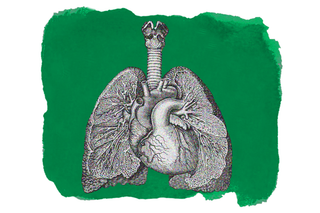
New Research Shows How Air Pollution Causes Lung Cancer Among Non‑Smokers
“It’s a wake-up call on the impact of pollution on human health. You cannot ignore climate health.”

Air pollution is a silent, invisible menace. Innocuous gray particles — no wider than a strand of hair — become clouds of pollutants, responsible for the death of 8.8 million premature deaths globally every year. The risk of respiratory infections, dysmenorrhea, dementia, cancer, mental health issues, and heart disease are all interspersed here. As to whether air pollution actually causes lung cancer — there’s plenty of anecdotal evidence. The death of 2,50,000 people due to lung cancer globally in 2019 was attributed to poor air quality.
So far, however, experts approached anecdotal evidence about the link between air pollution and lung cancer with caution. How exactly air pollutants could cause lung cancer, and what formed the biological reasoning behind the link, remained largely unclear. But scientists may finally know now how outdoor air pollution may trigger cancerous cells, and this knowledge has the potential to redefine our understanding of the illness — and even change how treatments and ecosystemsare designed.
Researchers at the Francis Crick Institute and University College London presented their findings at the European Society for Medical Oncology conference over the weekend. “The same particles in the air that derive from the combustion of fossil fuels, exacerbating climate change, are directly impacting human health via an important and previously overlooked cancer-causing mechanism in lung cells,” said Charles Swanton, one of the researchers of the findings. “Globally, more people are exposed to unsafe levels of air pollution than to toxic chemicals in cigarette smoke.”
The mechanism works something like this: the air particulate matter released by car fumes (highway vehicles are known to release about 1.7 billion tons of greenhouse gases into the atmosphere each year) appears to “awaken” mutations in lung cells, and in some cases, drive them to a cancerous state. At the heart of this process is a gene called the EGFR. Among half of the people with lung cancer who have never smoked, exposure to airborne particulate matter triggers mutations that are otherwise dormant.
The observation is based on both human and mice experiments. Among people, they looked at almost 2,50,000 people living across England, South Korea, and Taiwan. In areas where the particulate matter concentration was 2.5 micrometers (μm) in diameter — considered to cause the greatest harm among people — scientists observed EFGR mutations. Similarly, in experiments in mice, scientists engineered the EFGR gene such that they carried inactive mutations. When the mice were exposed to PM2.5 particles, the dormant cells turned cancerous. “The pollutant is the equivalent of the ignition spark on a gas hob,” as The Guardian put it.
Related on The Swaddle:
Why Some Lifelong Smokers Don’t Develop Lung Cancer
What about the PM2.5 particles “activates” the dormant mutation? They stimulate the release of interleukin 1β — a protein encoded in the human gene — that causes inflammation in the lung’s epithelial cells. These cells serve a critical role in maintaining immunity, helping the body repair after injury, and helping clear out particulate matter. An inflammation hampers their ability to function, which initiates tumor formation. PM2.5 then effectively works as an “environmental carcinogen.”
To put it simply: people carry dormant mutations of the EFGR gene in their cells, and persistent exposure to outdoor air pollution can very well increase non-smokers’ risk of developing lung cancer. “We have known about the link between pollution and lung cancer for a long time, and we now have a possible explanation for it,” said Tony Mok at the Chinese University of Hong Kong, not involved in the study.
What makes the research groundbreaking is that it offers a hint of clarity about an illness that is shrouded in a veil of obscurity. Common reasons for cancer include exposure to the sun and smoking, both of which cause genetic changes. The same wasn’t established in the discourse around air pollution causing — until now.
This has a bearing on how we treat lung cancer, given experts will now have more clarity on how exactly air pollution could cause lung cancer. “This research is intriguing and exciting as it means that we can ask whether, in the future, it will be possible to use lung scans to look for pre-cancerous lesions in the lungs and try to reverse them with medicines such as interleukin-1β inhibitors,” Mok pointed out.
Moreover, our “consumption of fossil fuels goes hand in hand with pollution and carbon emissions, we have a strong mandate for tackling these issues — for both environmental and health reasons.” This link critically ties environmental pollution with public health.
Unsafe levels of air pollution have raised concerns globally. Last month, a study revealed that 18 out of 20 cities with the most severe increase in PM2.5 concentration worldwidewere in India, with New Delhi and Kolkata topping the list. In 2019, air pollution caused an estimated 1.6 million deaths in India, which was the highest in the world. The illness burden is also disproportionately borne by people marginalized due to caste, gender, and class, due to increased exposure.
The research then makes a compelling case for reframing our approach to the climate crisis, and viewing it from the lens of human health. Relentless forces of production demand that the factories keep churning, and that emissions from steel vehicles continue to pollute the air we breathe. But what the research confirms is the air directly alters the human body, pushing it to decay and illness.
As Swanton noted: “It’s a wake-up call on the impact of pollution on human health. You cannot ignore climate health. If you want to address human health, you have to address climate health first.”
Saumya Kalia is an Associate Editor at The Swaddle. Her journalism and writing explore issues of social justice, digital sub-cultures, media ecosystem, literature, and memory as they cut across socio-cultural periods. You can reach her at @Saumya_Kalia.
Related


Why Romances, Heartbreaks May Impact Our Mental Health Less Than We Think
